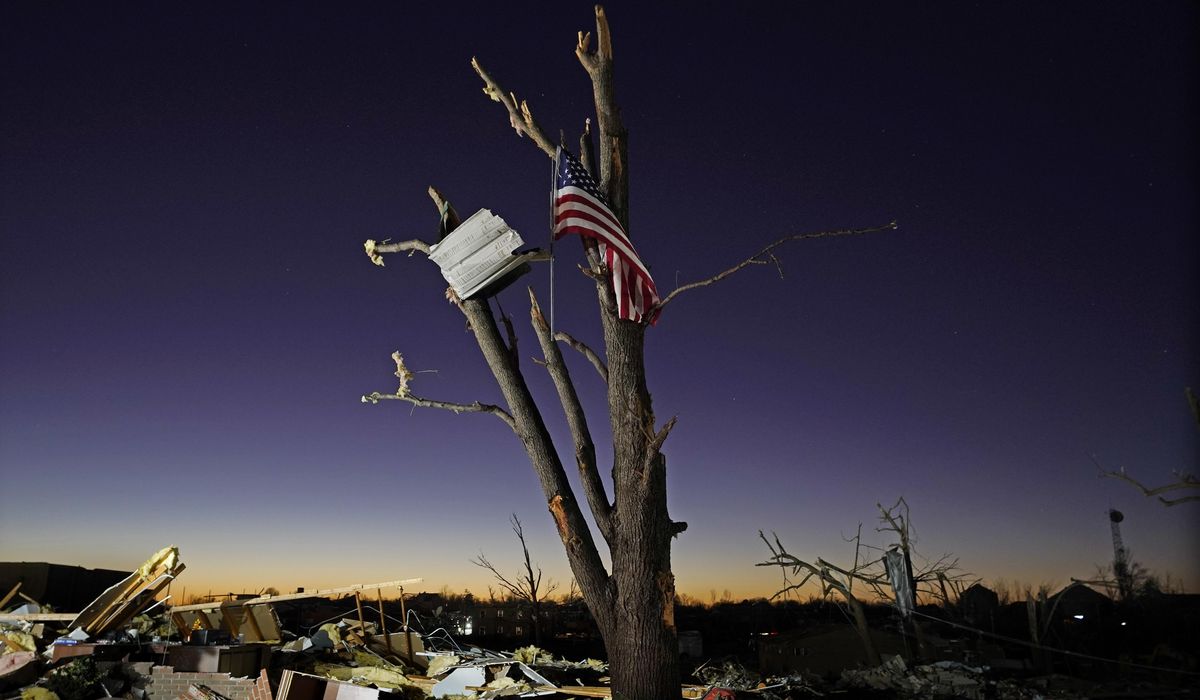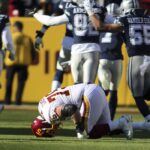
The Biden administration faced pushback Monday for pushing a climate change link to the deadly tornadoes that cut a path of destruction across Kentucky and neighboring states, leaving a trail of leveled buildings, shredded trees and mangled cars.
President Biden said Sunday that “we all know everything is more intense when the climate is warming” as the region reeled from one of the worst tornado disasters in U.S. history.
He took a more measured approach Monday, saying “we can’t say with absolute certainty that it was because of climate change.”
“There’s a lot of things that we don’t know for certain, and I don’t want to say anything that’s not precisely true,” Mr. Biden told reporters at an Oval Office briefing. “What is certain is it is one of the worst tornado disasters that we’ve had in the country, and the second thing that’s certain is it is unusual. It is unusual how it happened, how many places it touched down, and the length of the path.”
Not mincing words was Deanne Criswell, Federal Emergency Management Agency administrator, who said the late-season tornado swarm represented “the new normal.”
“This is going to be our new normal,” said Ms. Criswell on CNN’s “State of the Union.” “And the effects that we’re seeing from climate change are the crisis of our generation. We’re taking a lot of efforts at FEMA to work with communities to help reduce the impacts that we’re seeing from these severe weather events.”
The climate focus, coming as the administration seeks Senate passage of a $2 trillion climate-and-social spending package, triggered critics who argued that U.S. tornado activity has been flat since at least 1954 and accused the Biden administration of politicizing the disaster.
“Three is no evidence of any increase in tornado frequency or tornado intensity over the past 50 years,” said Steve Milloy, founder of JunkScience.com and a Trump EPA transition team member. “It’s awful in the aftermath of such natural disasters that climate activists and their politicians first think in knee-jerk fashion of advancing the climate agenda rather than helping the victims.”
Before the tornadoes touched down late Friday, the U.S. was in an extreme tornado “drought,” having broken in May a record for most consecutive days without an EF5 tornado, the most severe on the Enhanced Fujita scale, which measures tornado damage.
Ms. Criswell called the powerful December tornado “incredibly unusual.”
“We do see tornadoes in December. That part is not unusual,” she said. “But, at this magnitude, I don’t think we have ever seen one this late in the year. But it’s also historic. Even the severity and the amount of time this tornado or these tornadoes spent on the ground is unprecedented.”
Major December tornadoes are rare, experts say, but they’re not increasing in frequency. The number of EF3-EF5 tornadoes occurring in winter months has declined since 1950, geologist Tony Heller said on his Real Climate Science blog.
“For what it’s worth, it has been nearly 64-years since the last December EF-5 tornado was recorded in the United States (12/18/1957). The only other EF-5 on record for the month was on 12/05/1953,” tweeted meteorologist Chris Martz.
Biden uses tornado tragedy to further climate agenda: But ‘data shows that these winter tornadoes are not becoming more frequent’ | Climate Depot https://t.co/Lng2BelQtF pic.twitter.com/7B1jYRMiLO
— Marc Morano (@ClimateDepot) December 13, 2021
Mr. Biden said he would travel Wednesday to Kentucky to view the damage from the rare December weather system that produced a flurry of tornado activity, including one massive twister believed to have run continuously for about 227 miles.
At least 74 people were killed and another 109 were missing in Kentucky. Another 14 deaths were reported in Illinois, Tennessee, Arkansas and Missouri.
Mr. Biden, who has already signed an emergency declaration for Kentucky, said Monday that the affected states would receive “whatever they need, when they need it.”
He also said he would ask the Environmental Protection Agency to examine the connection between the disaster and climate change.
Kentucky Gov. Andy Beshear said that the twisters were the “worst tornado event in state history,” destroying at least 1,000 structures and leaving towns “in rubble.”
At a Monday briefing, he said he would seek federal assistance for another 20 counties, and that 448 National Guard troops were in the field conducting search and rescue missions.
One hopeful sign Monday was that the death toll at a candle factory in Mayfield, Kentucky, was lower than originally feared. Eight people were reported dead and eight missing after as many as 70 were at first believed dead.
“Many of the employees were gathered in the tornado shelter and after the storm was over they left the plant and went to their homes,” said Bob Ferguson, a spokesperson for the company. “With the power out and no landline they were hard to reach initially. We’re hoping to find more of those eight unaccounted [people] as we try their home residences.”
The struggle for residents of the hardest-hit counties now lies with the region’s hard-hit infrastructure. About 26,000 residences and businesses were without power Monday. More than 10,000 have no water, while 17,000 are under advisories to boil their water, said Kentucky Emergency Management director Michael Dossett.
Photos of the twister’s aftermath showed concrete slabs where buildings used to be; roofs and walls torn off homes, and debris stretching as far as the eye can see.
“It looks like a bomb went off. It’s just completely destroyed in areas,” Jack Whitfield Jr., the Hopkins County judge-executive, told The Associated Press.
Mr. Beshear said he believed the largest twister, dubbed the Great Quad-State Tornado, would ultimately be classified as an EF4 or EF5 tornado.
“When what I think will be an F4 or F5 tornado touches down and stays on the ground for 200 straight miles in a state with 120 counties, you have this many counties that have damage and this many counties that need help,” he said.
The Quad-State Tornado has drawn comparisons to the Tri-State Tornado of March 1925, the deadliest twister in U.S. history, which killed 695 people by most estimates as it passed through eastern Missouri, southern Illinois and southern Indiana.
The Tri-State tornado was believed to have traveled 219 miles on the ground, a record that could be broken by the Quad-State.
“Both the Quad-State Tornado and the Tri-State Tornado crossed the Mississippi River. Both tornadoes occurred in winter and were wide,” said columnist Bill Steffen on WOOD-TV in Grand Rapids. “The Quad-State tornado was at least 3/4-mile wide at one point. Both tornadoes were relatively fast-moving. The Tri-State Tornado was estimated to have moved at up to 73 mph.”
• This article was based in part on wire service reports.








